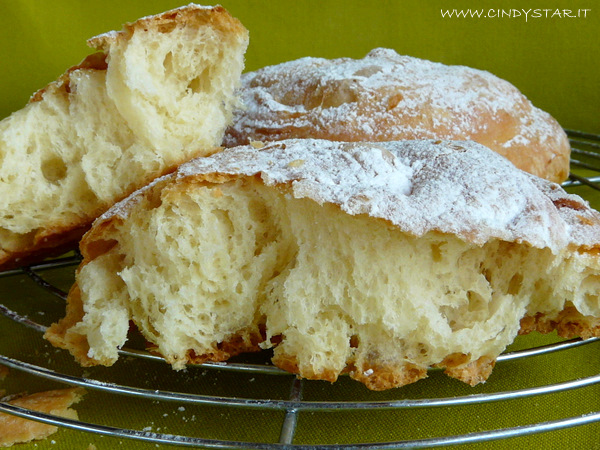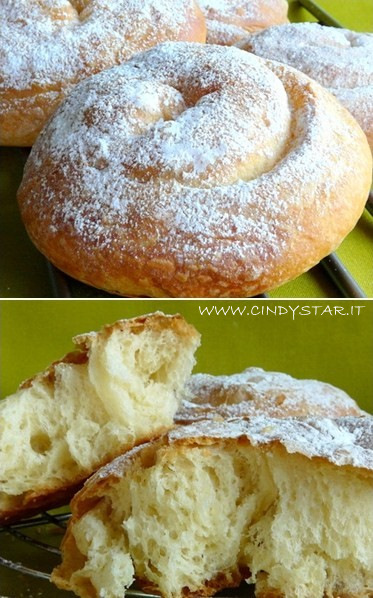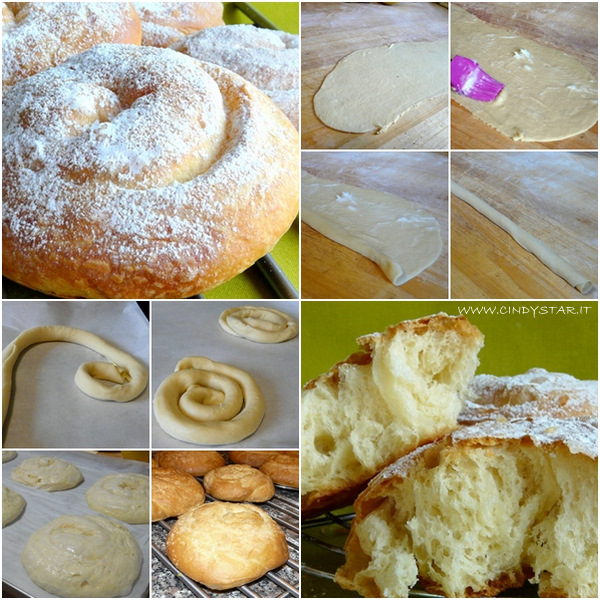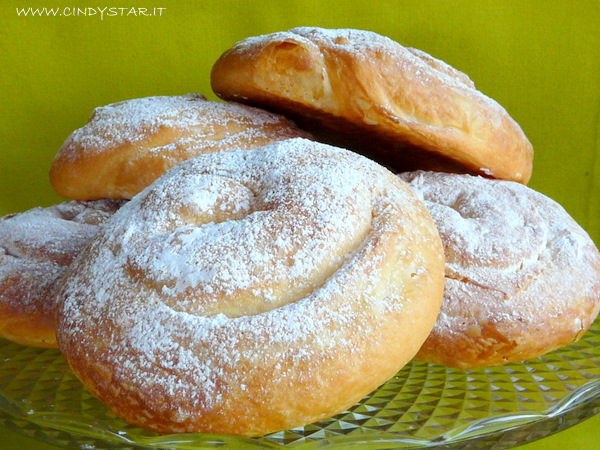February BBB - Ensaïmadas
Karen from Baking Soda is our hostess and kitchen of the month for the Bread Baking Babes.
I am very glad I followed her recipe because I discovered a very nice sweet bun, this morning I surprised my kids with warm, soft, brand-baked brioches on the table!
Ensaïmada is a typical sweet pastry from Majorca, very popular throughout Spain, Philippines and Puerto Rico ... and now on our table too!

You need:
500g all-purpose flour (plus additional as needed )
75g sugar
1/2 tsp fine sea salt
40g fresh yeast200-250ml lukewarm milk
2 eggs
2 tbsp olive oil
150g soft pork lard (that was too much indeed!, I used less)
powdered sugar for dusting
- Add the flour together with sugar and salt into a large bowl or in a stand-mixer and mix well. Make a hollow in the center, add the crumbled yeast as well as a decent pinch of sugar and pour over just enough of the lukewarm milk until the yeast is covered. Stir the yeast milk once or twice, then cover the bowl with a kitchen towel and let rest for about 15 minutes or until the surface of the yeast milk looks bubbly.
- Add the other ingredients (the remaining milk, eggs, olive oil ) and knead well, either by hand or with your kitchen machine until the dough comes together nicely. I used less milk (only 200 or 220 ml, while the original recipe suggests 250 ml) and my dough still turned out pretty sticky, I therefore added a tad more flour and let it knead at medium speed for 3/5 minutes, then it was ok. Let the covered bowl rest again in a warm place for at least 30 minutes or until the dough has doubled.
- Punch it down softly, then flip the dough onto a well-floured surface and sprinkle with flour. Cut into about 10 equally sized portions and form into neat little balls, before letting them rest – sprinkled with flour, covered with a kitchen towel – once more for at least 30 minutes.
- Shaping the Ensaimadas: Flatten one doughball, then roll out with a rolling pin (use flour as needed) until you get a pretty thin pastry in a long rectangular shape of about 20 cm. height: to get it easier I used the pasta making machine, rolling accessory. Brush it generously with the softened pork lard (just a few second in the microwave). Roll up cautiously.
Line the baking sheets with either parchment paper or silicone mats. Coil up the dough piece until it resembles the house of a snail (tuck the outer end under), ideally very loosely, because any spaces will fill up as the dough rises further. Place Ensaimadas on baking sheet, making sure to leave enough space between them. Lightly brush with lard and cover up again. I cover them with wet and wrung out kitchen paper and let rise in the oven (off, of course!). The next morning, if the paper dried just sprinkle with water (using a spray bottle), wait a few minutes and gently pull the paper off.
- Repeat with each dough ball.
- The final rise is supposed to last overnight, but I suppose something less could have been better, I found them overrisen (but I went to bed and happily slept!). Or perhaps try using less amount of yeast, 40 g are quite a lot for 500 g flour!
- Preheat the oven to 200° and bake for 14 to 16 minutes or until golden brown. Take out and let them cool down on a wire rack for a couple of minutes, then generously dust with powdered sugar and enjoy while still warm. Any favorite filling would be nice with them: jam, marmalade, honey, chocolate, nutella, whipped cream.

fluffy and soft , with a delicate crust
Ensaimadas Buddies
This recipe goes to Susan's weekly YeastSpotting.
YeastSpotting Round up 2.26.10
Ensaïmadas
Le Ensaimadas sono delle paste briochose tipiche dell'isola di Maiorca, ora popolari in tutta la Spagna, nelle Filippine e a Porto Rico. A partire dal1996 è stata riconosciuta come prodotto IGP "Ensaïmada de Mallorca".
Sono di una delicatezza estrema, molto soffici, non troppo dolci per non appesantirsi con gli eventuali ripieni. E questa mattina sono uscite belle calde e dorate dal forno ... puntuali per una ricca colazione!
Ingredienti:
500g di farina (più ancora per spolvero)
Sono di una delicatezza estrema, molto soffici, non troppo dolci per non appesantirsi con gli eventuali ripieni. E questa mattina sono uscite belle calde e dorate dal forno ... puntuali per una ricca colazione!
Ingredienti:
500g di farina (più ancora per spolvero)
75g di zucchero
mezzo cucchiaino di fleur de sel
40g lievito fresco
200-250ml di latte tiepido
2 uova
2 cucchiai di olio extravergine di oliva
150 g di lardo di maiale ammorbidito (per me era troppo davvero, ne ho usato meno)
zucchero a velo per guarnire
- In una ciotola grande o nella planetaria unire la farina con lo zucchero e il sale e mescolare bene. Fare una fontana nel centro, aggiungere il lievito sbriciolato e un pizzico di zucchero e versarvi sopra un po' del latte tiepido. Sciogliere il lievito, poi coprire la ciotola con un canovaccio e lasciare riposare per circa 15 minuti o finché non inizia a fare le bolle.
- Aggiungere gli altri ingredienti (il resto del latte, le uova, l'olio) e impastare bene, a mano o con la planetaria fino a quando l'impasto è ben amalgamato. Io ho usato meno latte (solo 200, mentre la ricetta originale dice 250 ml) ma il mio impasto era ancora un pochino appiccicoso, per cui ho aggiunto un paio di cucchiai di farina, ho lasciato impastare a velocità media per 3/5 minuti, poi era perfetta, morbida e liscia. Lasciare ancora l'impasto coperto nella ciotola in un luogo caldo per almeno 30 minuti o fino a quando sarà raddoppiato.
- Sgonfiare l'impasto dolcemente, poi capovolgere su una superficie ben infarinata e cospargere livemente con la farina. Tagliare 10 porzioni di uguali dimensioni e formare delle palline, che si lasciano riposare (cosparse di farina e coperte con un telo da cucina) ancora altri 30 minuti.
- Formazione delle ensaimadas: schiacciare una pallina di impasto, poi stendere con il matterello (aiutarsi con un po' di farina se necessario) fino ad ottenere una sfoglia abbastanza sottile in una forma rettangolare allungata di circa 20 cm. altezza: per facilitarmi il compito ho usato la sfogliatrice per fare la pasta. Pennellare generosamente con lo strutto di maiale ammorbidito (basta qualche secondo nel microonde). Avvolgere la pasta su se stessa dal lato lungo fino a formare un rotolo.
Ricoprire le teglie del forno con carta forno. Arrotolare il pezzo di pasta su se stesso fino a che non assomiglia alla casa di una lumaca (attaccare l'estremità finale sotto), anche molto largamente, perché gli spazi si riempiranno durante la lievitazione. Sistemare le ensaimadas sulla teglia da forno, facendo attenzione a lasciare abbastanza spazio tra di loro. Pennellare leggermente con lo strutto e coprire di nuovo. Io ho usato carta da cucina bagnata e strizzata bene, e ho messo le teglie a lievitare in forno (spento naturalmente!). La mattina successiva, se la carta si è seccata, basterà spruzzare dell'acqua (con uno spruzzino), attendere qualche minuto e delicatamente la carta verrà via con facilità.
- Ripetere per ogni pallina.- La ricetta dice che la lievitazione finale prosegue per tutta la notte, ma penso che potevano essere pronti anche qualche ora prima perchè li ho trovati più che lievitati (sono andato a letto e ho dormito tranquilla!). O forse basterebbe utilizzare meno lievito, 40 g sono un pochino tanti per 500 g di farina!
- Preriscaldare il forno a 200° e cuocere per 14 a 16 minuti o fino a doratura. Estrarre e lasciare raffreddare su una griglia per un paio di minuti, poi cospargere generosamente con zucchero a velo e gustare finchè sono ancora calde. Qualsiasi ripieno preferito le renderà ancora più buone: confetture, marmellate, miele, cioccolato, nutella, panna montata.

Questa ricetta partecipa a "Brioche...la raccolta" di Laurae alla raccolta "Basta un poco di lievito" di Betty
Questa ricetta partecipa alla raccolta della Spagna, ospitata da Francesca di Burro e Zucchero per l'Abbecedario della Comunità Europea.

















12 commenti:
What a great photo collage you made! I would have loved to join you at your breakfast table (you deserve a "best mom badge" as well for laying out such a treat) Thanks for baking with us!
I love your photos! They almost look like croissant buns. I'll bet they made a fabulous breakfast.
MA che belle queste briochine di Maiorca! da provare!
Wow, these look great. I totally forgot to dust mine with powdered sugar - it really makes a difference!!!!
Thank you, Karen and Hobby, it's a pleasure to bake such lovely recipes with the Babes!
ap269, powdered sugar add a little sweetness too, but you are always in time to do it lateer...ora have you eaten already all?
Have a nice w.e.!
Grazie, Terry, una è anche per te!
wow those rolls look divine, happy kids there with such a talented cook/baker for a mom!!!
These look absolutely wonderful! Wish I had one right now for breakfast! I'll have to make these for my daughter-in-law; she is from the Philippines:)
Delightful! I love how thin you rolled them.
Beautiful looking rolls.
Thanks so much for baking with us again this month. :)
belle e particolari queste briosche!!!invitano alla prova...buona domenica Tittina
Thank you Lien, but sometimes kids forgot how lucky they are!...ensaimadas were not sweet enoufh for them...without thinking they could put a sweet filling inside!
Sue, ask your daughter if they use the same recipe or some alternative!
Natasha, that was real help with pasta making machine, they came out really thin without any effort!
Tittina, grazie, buona domenica anche a te!
Puoi prenderne una per la colazione di domani!
Beautiful snails! I have never heard of this bread before--fascinating . . . Great photos illustrating the process (and I appreciate the link to videos).
Thank you,Laura!
BBB are great and always find intriguing recipes for the challanges.
Have a nice w.e.!
Posta un commento
grazie della visita e gentilmente firma sempre i tuoi commenti!
thanks for passing by and please sign up your comments!